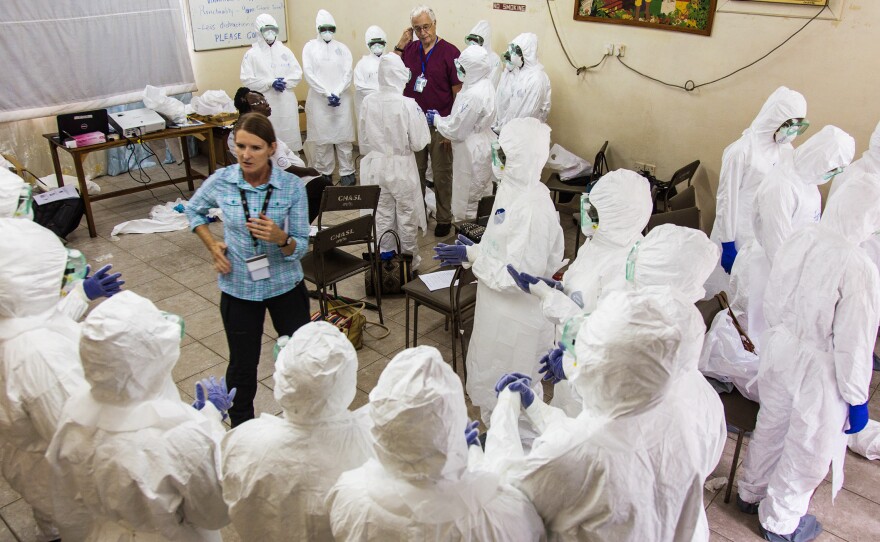As health officials in the Democratic Republic of Congo work urgently to try to stop the spread of another deadly Ebola outbreak, some San Diego scientists are working to find a cure for the highly contagious disease.
“So we’re flying from San Diego to Congo with eight crates of supplies to go and do our laboratory work there and bring the data back here,” said Erica Ollmann Saphire, a professor at the La Jolla Institute for Immunology, and director of a consortium of Ebola researchers from 40 labs on five continents.
Ebola has killed more than 1,000 people in and around the Congo since last August, and the rate of new infections is climbing substantially, the World Health Organization reported Monday. Nearly half of the deaths have occurred in the last eight weeks.
Ollmann Saphire said the difference between this Ebola outbreak and the outbreak in 2013 that killed 11,000 people, is a candidate vaccine currently being used in the region to immunize health workers, people who have come into contact with Ebola patients, and contacts of the contacts.
"I think without that vaccine, the outbreak would be much larger right now," she said. “The challenge of stopping (Ebola) is going to be all the civil unrest. There are multiple militia groups, significant distrust of institutions of governments, significant distrust of foreigners, so it’s really hard to come in there and say, 'Here take this vaccine,' or 'Let us take care of your people.'"
More than 100,000 people have been vaccinated out of the nearly 8 million people who live in the region, she said.
“It looks so far like only 15 of those have become sick,” she said. “The data that we don’t have is how many of those 100,000 have been exposed and that will tell us how effective the vaccine is. If 100,000 have been exposed and 15 got sick, that’s a really good vaccine. But if only 20 were exposed and 15 of those 20 got sick, that’s not a very good vaccine.”

According to the WHO, the Ebola virus spreads quickly and is usually fatal. Symptoms include fever, vomiting, diarrhea, muscle pain and internal and external bleeding.
Ollmann Saphire’s team is studying samples from people who have been vaccinated, and samples from people who have come into contact with an Ebola patient.
“Students, postdocs and technicians in my lab with the La Jolla Institute of Immunology have been rotating in and out of Congo all year using the molecules that we make and that we engineer here to identify cases, understand what kind of immune responses have been elicited by the vaccine and how broadly protective the vaccine may be or may not be,” Ollmann Saphire said.

The current Ebola outbreak is deeply concerning because the virus is spreading in a dense and highly mobile population near the border with Uganda and Rwanda, she said. But even more concerning, is the five or more other strains of the Ebola virus that have equally deadly pandemic potential.
“There are six different kinds of Ebola virus and they’re about 50% different in the sequence that spells them out,” she explained. “So the vaccine is only protective against one. We call this the Zaire kind. Well, there’s also the Sudan kind, the Bundibugyo kind, the Bomboli kind, lots of kinds. And each one has equivalent pandemic potential. But we don’t know what’s going to emerge next.”
Studying the antibodies Ebola survivors have made is key in finding a treatment, she said.
“We’re looking at people who have survived," she said. "We’re looking at elderly with a lifetime exposure of hunting, of eating bush meat or of health care workers that are now immune to all of these different species. And we’re looking at what their immune system has come up with to protect them.”

She’s mapping the virus’s molecules using high-resolution photographs to understand where the virus is vulnerable and where to target a therapy or vaccine. She compared it to military intelligence photos.
“When we know how to drop a bomb on a particular bad guy on a particular chair sitting in a particular room in a particular compound without collateral damage is because we had those high-resolution photographs that tell us exactly where to hit,” she said. “This is what my lab does against viruses like Ebola. We take these high-resolution photographs to figure out how does the virus infect, where is it vulnerable, where can we target a therapeutic or how do we design a vaccine that’s going to beautifully mimic this virus and give a person immunity before they get exposed.”
For Ollmann Saphire and her team, the Congo outbreak and the potential of related viral outbreaks, has renewed her urgency to find a cure.
“We need to be prepared for what might come at us for the next outbreak," she said. "We need vaccines that are broadly protective and we need treatments that we can mobilize for whatever people might have become infected with.”
Ollmann Saphire is planning to return to the Congo to study Ebola this summer.







